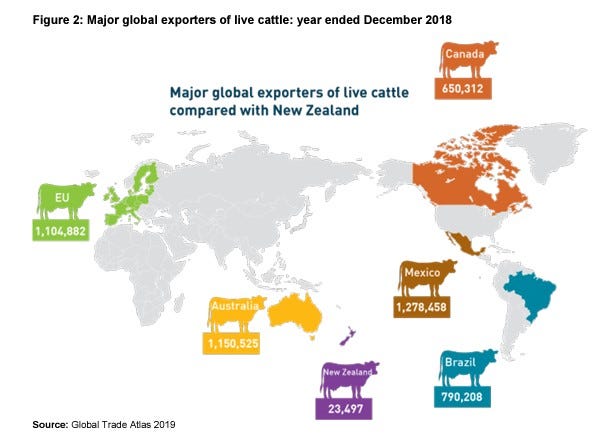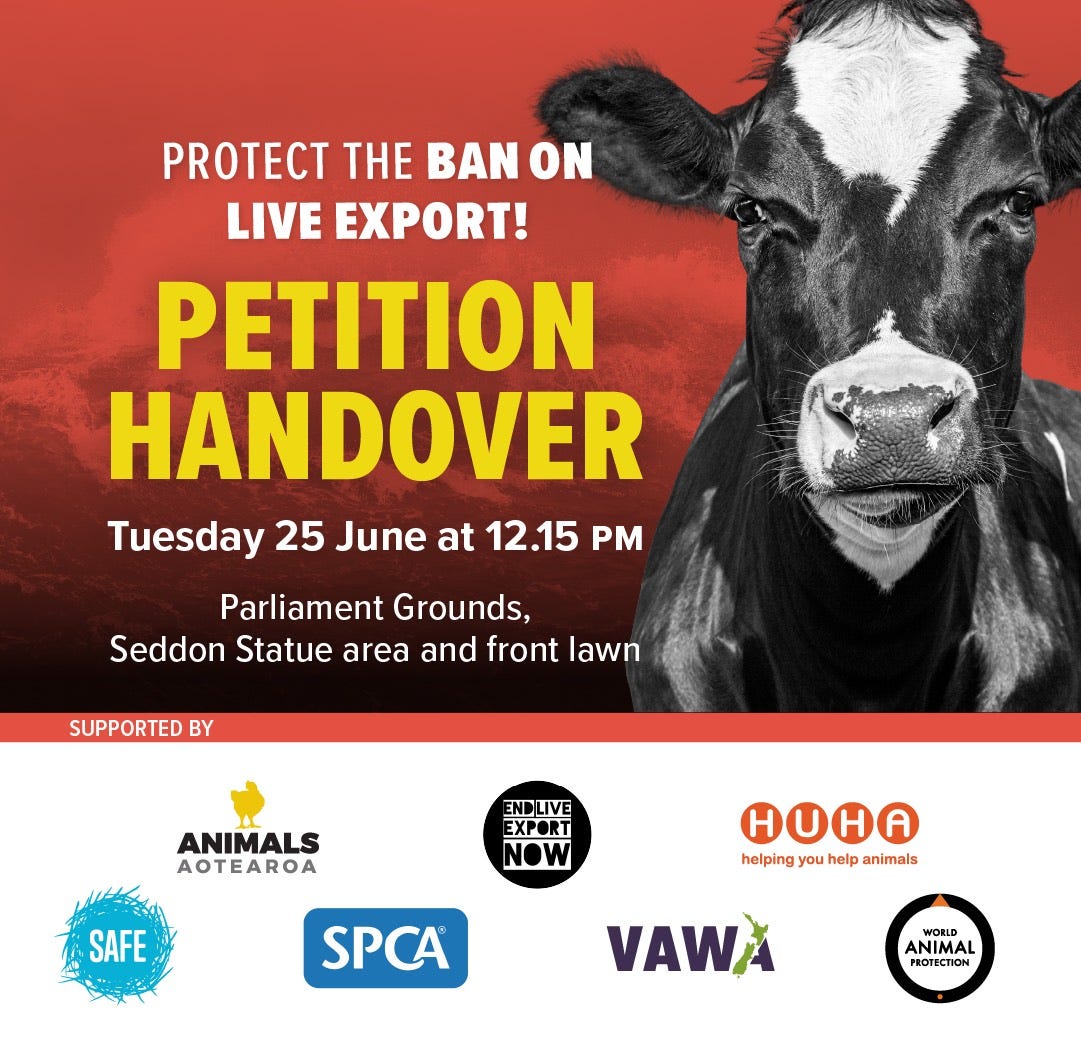Explainer: Are we about to lose this world-leading, hard-fought ban?
An explainer on the at-risk Live Animal Exports ban.
Here at Emily Writes Weekly we often do ‘Explainers’ on important issues that can be hard to get your head around. We get an expert (or experts) in and ask the basic questions so we can educate ourselves and work out what’s going on across the motu. I’m always learning alongside you - and I hope you find these explainers helpful.
I’ve been thinking a lot about live animal exports. Aotearoa has a long history of exporting live animals but on 30 April 2023, we enacted a world-leading ban on the live export of cows, sheep, deer and goats by sea. I’d heard this ban was at risk so I decided to ask an expert to give us a run-down of what’s actually going on.
Dr Helen Beattie grew up on a South Island Central High Country station before going to Massey University. Her veterinary career started off in a clinic in North Otago treating animals both big and small. Since then she’s owned a veterinary clinic, worked on the United Kingdom’s foot and mouth response and been Aotearoa’s Chief Veterinary Officer. She’s also the head of Veterinarians for Animals Welfare Aotearoa. In short - she knows her stuff.
I’ve asked her to talk us through what we need to know about live animal exports.
Emily: What animals do we export in Aotearoa and where are they going?
Dr. Beattie: We export all sorts of animals including cats and dogs - about 6011 - and horses - 2379 to be exact - and every now and then a lizard or other zoo animal. There are other bits and bobs too, such as embryos and semen, birds and alpaca and llamas too.
We also export a huge number of farmed animals, which include millions of one-day old chicks - 3.1 million in 2023, and some sheep - 195 in 2023, goats - 3778 and cattle - over 28,500. While bees aren’t included in the ‘animal’ category, we also export lots of bees, more than 33,000 annually.
Interestingly, we also export a taonga - our kōura and long-finned eels - which are recognised as being sentient, meaning they have feelings and emotions that matter to them and they can suffer. They are not listed in the animal export data, and despite being sentient, exporters do not require an animal welfare export certificate.

An animal welfare export certificate is called an AWEC and it provides some rules about exporting. It should ideally provide protection of exported animals’ welfare. It doesn’t always of course, because cattle require an AWEC and they still suffer. But we’ll come back to that.
Many animal welfare advocates have grave concerns about kōura and eel experiences, and their life after export, including being held in crowded tanks prior to being killed, often inhumanely, and then eaten.
Many of us veterinarians and advocates also worry about the one-day-old chicks. Despite being flown and having a shorter journey many still die during export.
The numbers that die are hard to come by, except for cattle - and although mortality might be reasonably low, in the view of many of us, the number of cattle that suffer is 100%.
New Zealand banned live exports of sheep and cattle for slaughter in 2003. This happened after Saudi Arabia rejected a shipment of 57,000 sheep on board the MV Cormo Express. After two months at sea and unable to find port, thousands of sheep died on board and the rest were gifted to the poor northern African nation Eritrea, where many were inhumanely slaughtered in small makeshift abattoirs.
This might sound like a long time ago and a bit irrelevant - except that we just saw the very same thing play out in Australia in early 2024 aboard the Bahijah. Some 16,000 sheep and cattle were ordered back from the Red Sea to Fremantle due to the possibility of Houthi attacks, because the ship was Russian-flagged.
This is all to say that the live export trade is risky, and when there are sentient animals on board, there’ no room for mishaps and turnarounds. There’s not enough fodder on board, space is too limited and overall, welfare is too poor on board - it’s simply not fair to the animals. It’s much harder to moor up with them onboard, than a cargo load of Lego in containers.
How do we export them?
Many of the animals I’ve talked about go by air and have a short, safe and high welfare journey.
For example, the race horses all go with a team of people, that may include a veterinarian and always includes a senior air groom who has access to medications and facilities to treat horses if things go wrong.
Some of your readers will have experienced exporting the family cat or dog. They almost always are well taken care of. They don’t get sick and we certainly don’t expect them to suffer and die on their journey.
However, many veterinarians and animal welfare advocates do have concerns about the export of one day chicks, eels and kōura - they are sentient and have few welfare protections available to them during export. And this needs to be fixed. All sentient animals should have welfare protection afforded to them, including during export.
And this isn’t happening?
Export of sheep and cattle for slaughter was banned in the early 2000s.
However, the export of cattle was being done via sea until 1st May 2023 - we have had very serious concerns for the experiences that these animals had during sea export. So of course we celebrated the ban being announced.
It sounds like it needed to be banned because live cattle export seems pretty horrific. What’s it like?
Despite what the industry says, animal welfare cannot be managed on board livestock exports vessels. There is no system to manage the animal urine or faeces - the cattle literally lie in their own waste, which is then washed out every five to seven days by a high pressure hose, often running over the cattle below before going out to sea.
It gets very very hot and humid when crossing the equator and with no way to cool the animals down, they become very heat stressed.
Living conditions are very cramped, and lots of animals get injured from the rough flooring, which is needed for grip on a sea voyage, but that also causes grazes and scratches that get infected because of the dirty living conditions.
How did the ban on animal exports come about?
Animal welfare advocates had for years been campaigning to have farmed animal export by sea banned. But some farmers, veterinarians and the exporters who benefited from the practice defended it, and successive governments weren’t prepared to take them on.
In 2020, a livestock export ship - Gulf Livestock 1 - sailed from Aotearoa and sank in a typhoon, killing 41 people and 5867 cattle.
MPI had been in the process of reviewing livestock exports, and following the sinking, the then Minister of Agriculture, Damien O'Connor set up a review - the Heron review - to look at the practice more thoroughly and provide him with advice.
He then announced a complete ban would be put in place from 1st May 2023.
And now is this ban on animal exports at risk?
Yes! There’s a lot of bad things this government is doing from repealing smoking laws, removing the Māori Health Authority, and attacking water reform while undermining Te Tiriti o Waitangi and planning to decimate our environment and kill Archey's frogs, but they are also determined to repeal the ban that was quite literally, world leading.
We really need people to see how serious it is - because we need people to fight any change to the ban.
The UK just followed us and banned live animal export by sea and Australia just announced a ban on sheep exports. We are literally sailing in the wrong direction! It’s embarrassing and so distressing for those of us who have worked so hard to get the ban.
Why should we care?
You should care because animals deserve better - we have a duty to protect them, and the profits of a few should not be at the expense of hundreds of thousands of animals. And it really is a tiny amount of profit for a tiny few - and yet despite all that risk and suffering, the National-led government seems set on repealing the ban.
When announcing the ban, O’Connor, said, "Live exports by sea represent approximately 0.2 percent of New Zealand's primary sector exports revenue since 2015 and O'Connor said while it had benefits for some farmers it was not universally supported in the industry."
OK, so what can you do?
We have a petition that we would so appreciate people signing and sharing. It closes at 11.59pm on Friday. Please share it. You can also come along with us when we present it at Parliament - details of the event are here.
You can also follow Veterinarians for Animal Welfare Aotearoa and check in on our website so you can join us at the petition handover event and make your voices heard.
We’re also hoping people will use the hashtag #protecttheban and share this post to protect animals from unnecessary suffering.








Signed and shared!
Proud to sign & support this kaupapa... Ashamed the people of Aotearoa elected people who are so backwards when it comes to ALL the things that make us decent human beings that they callously turn back the clock on recent progress in improving human & animal welfare 🤬